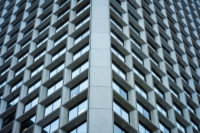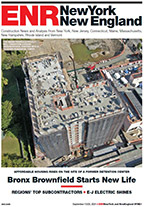September Construction Starts Climb 10% Nationwide
New construction starts in September advanced 10% to a seasonally adjusted annual rate of $604.1 billion, according to McGraw Hill Construction, a division of McGraw Hill Financial. The increase followed an up-and-down pattern during the previous two months and brought activity to its highest level so far during 2014.
Nonresidential building registered a sharp gain, helped by an elevated pace for several institutional categories plus another brisk month for manufacturing plants, while the nonbuilding construction sector (public works and electric utilities) also strengthened. Running counter in September was a decline for residential building. During the first nine months of 2014, total construction starts on an unadjusted basis were $419.5 billion, a 5% gain compared to last year.
The September data lifted the Dodge Index to 128 (2000=100), up from a revised 116 for August and put it slightly ahead of July’s 126 (the previous high for this year).
“While the progress for construction starts has been uneven at times on a month-to-month basis, the quarterly averages show that an upward trend has been re-established,” said Robert A. Murray, chief economist for McGraw Hill Construction. “In this year’s first quarter, construction starts fell back 10% but then climbed 6% in the second quarter and another 6% in the third quarter. A key factor in keeping the construction expansion going in 2014 has been the greater role now being played by nonresidential building. Commercial building has continued to see moderate growth from low levels, and the manufacturing building category is still showing a surge of chemical and energy-related plants reach groundbreaking.
“What’s different in 2014 is that the institutional structure types are now beginning to contribute to the nonresidential building upturn,” Murray said. “In contrast, both public works and electric utilities have generally lost momentum during 2014, notwithstanding their strong showing in September. And, residential building is now providing a much smaller lift than in the past two years, as the sluggish performance by single family housing has outweighed further gains by multifamily housing.”
Nonresidential Building
Nonresidential building in September increased 15% to $228.5 billion (annual rate), after pulling back in August. The institutional building group soared 33%, with substantial support coming from a 322% hike for the amusement and recreational category, which reflected the start of the $948-million Atlanta Falcons retractable-roof stadium in Atlanta and $717 million for the casino portion of the $925-million National Harbor MGM Casino Resort in Oxon Hill, Md. Also climbing sharply in September was transportation terminal work, up 171%, led by the $240-million renovation of the 95th Street train and bus terminal in Chicago and a $144-million aircraft hangar in Wichita, Kan.
Educational facilities, the largest nonresidential building category by dollar volume, climbed 34% in September. Large projects that helped to lift the educational total included a $150-million research lab in Cambridge Mass., plus several sizeable high schools—two in Texas valued at $150 million and $100 million respectively, and a $130-million high school in Washington.Through the first nine months of 2014, the educational facilities category increased 10% from a year ago, including a 16% gain for high schools.
The public buildings category (courthouses and detention facilities) in September grew 11%, but religious buildings fell 30%. The health care facilities category in September plunged 44%, sliding back from a strong August, although the latest month did include the start of a $206-million hospital expansion in San Antonio, Texas.
The manufacturing plant category in September surged 105%, continuing to show the highly volatile month-to-month behavior that’s been present during 2014. Providing the upward push in September was the start of a $1.3-billion methanol plant in Louisiana and a $225-million tire manufacturing plant in Georgia. The commercial building group in September fell 15%, retreating from its heightened amount in August. Store construction declined 22%, after being lifted in August by the $157-million retail portion of the $957-million Nordstrom Tower in New York City.
Office construction dropped 23%, although September did include the start of such projects as a $700-million data center for Microsoft in West Des Moines, Iowa, a $250-million office tower in Chicago, a $105-million office tower in Houston, and a $100-million headquarters building for American Greetings in Westlake, Ohio.
Hotel construction in September slipped a modest 1%, with some support coming from $140 million for the hotel portion of the National Harbor MGM Casino Resort in Oxon Hill, Md. Warehouse construction was the one commercial structure type able to post a gain in September, rising 2% with the help of groundbreaking for a $90-million distribution center in Georgia.
Nonbuilding Construction
Nonbuilding construction, at $162.9 billion (annual rate), jumped 38% in September. The electric utility category, which has trended downward for the past year and a half, climbed 107% from its lackluster August pace. There were two very large electric power plant projects included as September starts—a $1.7-billion retrofit of a coal-fired power plant in Illinois and a $1.0-billion solar power facility in Nevada.



